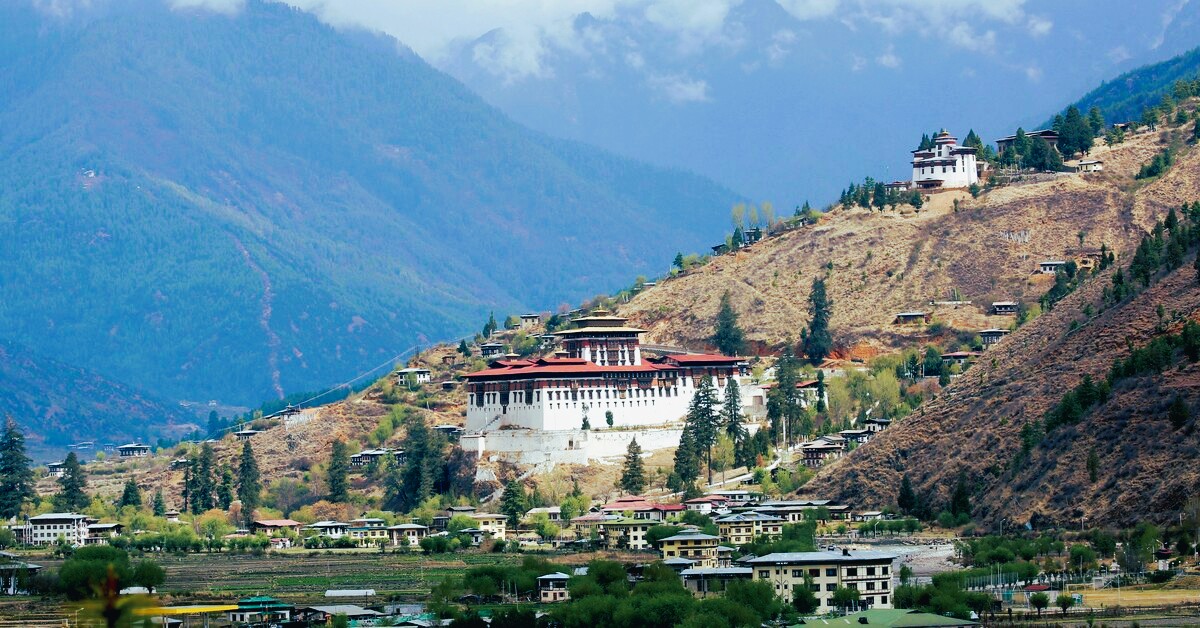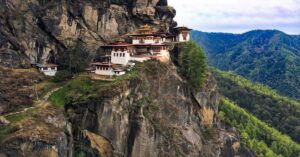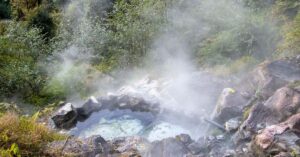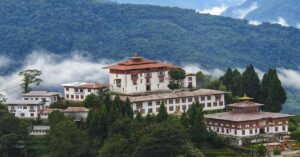Paro Rinpung Dzong, also known as Paro Dzong, is one of the 16 dzongs built by the Zhabdrung Ngawang Namgyal in Bhutan in 1646 at the site of Hungrel Dzong as a defensive fortress against the Tibetan invasions. It is one of the biggest dzongs in Bhutan.
The Rinchen Pung Dzong, the “Fortress on a Heap of Jewels,” stands perched on a hill above the Paro Valley facing Ugyen Pelri Palace at 2364 meters above sea level in Paro Dzongkhag.
Rinpung Dzong was built to serve as a fortress protecting the Paro Valley from Tibetan invasions. The Dzong now functions as both an administrative center and a residence for the monastic body of Paro District. It is a tentative site in Bhutan’s Tentative List for UNESCO inclusion and is one of Paro’s most popular major tourist attractions. Paro Fort is also famous for the Paro Tshechu Festival, which is held in spring. You can also witness the Dzongdrakha Tshechu at the same time.
Also Read: Dzongdrakha, where a Relic of Chorten and Sangay Youelsum was Discovered from a Cliff
How to Reach Paro Rinpung Dzong
Paro Dzong is located on the other side of the Pa Chhu River and is about two kilometers from the Paro airport. You can see this magnificent Dzong when you arrive at Paro International Airport. It takes less than 15 minutes to get to the fortress. To enter Paro Rinpung Dzong, one must cross the traditional wooden cantilever bridge Nyamai Zam over the Paro River. It is open daily from 8 AM to 6 PM, and entry is free.
Also Read: Wangdue Phodrang Dzong, the Fortress of Glorious Unification
History of Rinpung Dzong
According to Paro Dzong’s history, Guru Padmasambhava visited the site where the dzong stands today in the 8th century and named it “Rinpung Drak”, the cliff of the heap of jewels.
In the 14th century, Thangtong Gyalpo visited this sacred site and renamed it Hungrel Drak after uttering Hung to tame the deity of the cliff.
When Lama Drung Drung Gyelchog, the descendant of Phajo Drugom Zhigpo, visited this place in the 15th century, he built a five-story Dzong with rammed earth and named it Hungrel Dzong.
Also Read: History of Hungrel Dzong, a Fortress on the Holy Site of Guru Rinpoche
However, when Zhabdrung Ngawang Namgyal visited Paro to build a Dzong to defend against Tibetan invaders, the descendants of Hungrel Lama offered the Hungrel Dzong to Zhabdrung Rinpoche.
Zhabdrung Rinpoche dismantled the Dzong in 1644 and rebuilt it with the help of the first Paro Penlop, La Nangpa Tenzin Drukdra. It was consecrated in 1646 and renamed Rinchen Pung Dzong, which means “Fortress on a Heap of Jewels,” since Guru Rinpoche had named the cliff “Ringpung Drak”.
Also Read: Punakha Dzong, the Palace of Great Bliss on the Heaped Jewel
Paro Rinpung Dzong survived the massive 1897 earthquake but was damaged by fire in 1906. Fortunately, the most sacred relic within the dzong, the Guru Tsengye Thongdrol, was saved. The Thangka is still displayed on the final day of the Paro Tshechu festival.
The Dzong was rebuilt in 1909 under Penlop Dawa Penjor, maintaining its original design, led by master carpenters from Paro. He also added statues of Buddha, Guru Rinpoche, and the Zhabdrung.
Significance of Paro Rinpung Dzong
Rinpung Dzong, Paro Dzong, is Bhutan’s significant cultural, religious, and administrative landmark. The Dzong played a vital role in the country’s history as a defensive fortress against repeated Tibetan invasions during the 17th and 18th centuries. It also served as the meeting hall for the National Assembly of Bhutan. Rinpung Dzong houses a Sacred Rim (Cymbal) discovered from Nubtshonapatra Lake by Terton Sherab Mebar.
Also Read: Significance of Zhemgang Dzong, the Symbol of Unification of Khengrig Namsum
Description of Paro Rinpung Dzong Complex
Paro Dzong is a complex of courtyards, temples, administration offices, and open spaces surrounded by towering walls. Just outside the Dzong is the Deyangkha Temple, which is just as sacred as any other temple in Bhutan.
Since the dzong is built on a steep hillside, the courtyard of the administrative section is higher than the courtyard of the monastic portion, which marks a formal entrance.
The entrance of the dzong, with a big wooden door traditionally carved with Bhutanese architecture, is guarded by two traditional paintings on either side of the gate. One shows a Mongol holding a tiger on a leash, and the other depicts a man holding a black yak.
Visitors are restricted to the administrative section of the Dzong and must move toward the monastic section. In the monastic Dochey (courtyard) is the five-story Utse (Central Tower) built during the first Paro Penlop in 1649.
The Dzong has 14 shrines and chapels. The Goenkhang houses statues of Mahakala and Mahakali, while the Terton Lhakhang has a statue of Gonpo Man-ing, an emanation of Mahakala. Mithrugpa Lhakhang, built by the 10th Penlop Sherab Wangchuk, houses statues of Lord Buddha and Zhabdrung. Likewise, the Dukhang features a statue of Lord Buddha crafted by Penlop Dawa Penjor and has lovely exterior murals depicting the life of Milarepa.
One of the Dzong’s distinctive features is a small Lhakhang devoted to Chuchizhey, the eleven-headed Avalokiteshvara, located at the base of the eastern tower.
Also Read: Description of Gasa Dzong, the Fortress that defended against Northern Invasions
Paro Tshechu Festival
Paro Tshechu is one of the most popular religious festivals in Bhutan. It is held for five days, from the 11th to the 15th day of the second month of the Bhutanese lunar calendar in the Deyangkha ground. Gyalse Tenzin Rabgye introduced the festival in 1687 in honor of Guru Rinpoche.
The festival’s highlight is the unfurling of Thongdrol, which depicts the eight manifestations of Guru Padmasambhava before the break of dawn on the final day, to keep to the tradition of avoiding sunlight falling on it. Lama Nawang Rabgay made this sacred Thongdrel with materials from Tibet in the 18th century.
Dzongdrakha Tshechu is held at Dzongdrakha Monastery on the day before and the day after the Paro Tshechu.
Also Read: The Festival of Tashichho Dzong, a Fortress at the Site of Blue Stone Dzong
Best Time to Visit Paro Dzong
The best times to visit Paro Dzong are spring (March to May) and autumn (September to November). If you plan to attend the Paro Tshechu festival, the best time to visit is spring, typically around March or April. It is an incredible opportunity to immerse yourself in Bhutanese culture and spirituality. However, you should arrive early to secure a good viewing spot. You can visit the major pilgrimage sites of Paro with the Bhutan Pilgrimage Package.
Conclusion
Paro Dzong, also known as Rinpung Dzong, is a historic fortress built in 1646 under the guidance of Zhabdrung Ngawang Namgyel. Strategically located on a hill overlooking the Paro Valley, it served as a military stronghold and a religious center. The dzong is renowned for its impressive architecture, featuring massive buttressed walls and a five-story central tower. It houses government offices and monastic quarters, symbolizing the balance between civil and spiritual leadership in Bhutan. The site is also famous for defending against Tibetan invasions and hosting the Paro Tshechu festival.
Sacred Places to Explore in Paro
Hungrel Dzong: It was a fortress built on the sacred site of Guru Rinpoche. The Dzong was constructed by Drung Drung Gyelchog in the 15th century.
National Museum of Bhutan: Located just above Paro Rinpung Dzong, the National Museum, housed in a former watchtower, Ta Dzong, showcases a vast collection of Bhutanese artifacts, from ancient weapons and religious thangkas to masks used in traditional dances.
Druk Choeding Lhakhang: Also known as Tshongdoe Naktshang, it is a two-story temple built by Lama Ngawang Chhogyal in Paro in 1525.
Tiger’s Nest Monastery (Taktsang Monastery): Perched on the edge of a cliff, legend has it that Guru Rinpoche came here riding a tigress, making it one of the most sacred sites in Bhutan.
Kyichu Lhakhang is one of the oldest temples in Bhutan, built by Songtsen Gampo in 659 CE. It was built as part of the 108 temples constructed in a single day to pin down an ogress who was opposed to the spread of Buddhism.
Zuri Dzong: One of Bhutan’s oldest and most historically significant fortresses in the sacred site of Namthong Karpo. Built in 1352, it served as a defensive structure against invasions.
Frequently Asked Questions
Why was Rinpung Dzong built?
Rinpung Dzong was built primarily as a defensive fortress to protect Paro valley and its residents from invasions, particularly from Tibet, and as an administrative center to serve both religious and secular functions in western Bhutan.
When was Rinpung Dzong built?
Rinpung Dzong, also known as Paro Dzong, was built in 1646 by Zhabdrung Ngawang Namgyal.
Enjoyed reading this blog?




